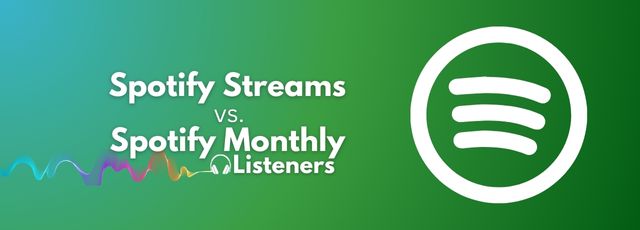Spotify has around 11 million music artists and 551 million monthly listeners as of 2023.
What does this statistic suggest? The platform still hasn’t reached its saturation point. So, launching your music career on Spotify is literally the best move you can make right now!
But that’s not all. You should also focus on growing as fast as you can. Whether you do this yourself or using a Spotify growth website – putting all of your efforts can give amazing results.
In today’s post, we will help make this easier for you by unlocking the difference between two key metrics: Spotify streams and monthly listeners. Let’s dive in!
Spotify Streams vs. Monthly Listeners
Spotify Streams and Monthly Listeners are both important measures on Spotify, but they show slightly different things.
Spotify Streams refer to the number of times a song has been played by listeners. So, if someone listens to a song once, that’s one stream. If they listen to it again, that’s another stream. It’s like counting how many times a song has been heard in total.
On the other hand, Monthly Listeners tell us how many unique people or accounts are listening to an artist’s music each month. If you listen to an artist multiple times in a month, you’re still counted as just one Monthly Listener. It shows how popular an artist is over a month and gives an idea of their fanbase size.
In simple words, Streams count the total plays of songs, while Monthly Listeners count the number of different people listening to an artist’s music within a month. Both are important to understand an artist’s reach and popularity on Spotify.
Why Is It Important to Understand These Metrics?
Understanding metrics like Spotify Streams and Monthly Listeners is crucial because they provide valuable insights into the music’s performance and audience engagement.
Spotify Streams show how often people are actually listening to an artist’s songs. By tracking streams, artists can see which songs are most popular and which ones might need more promotion. This helps them make decisions about which songs to focus on and which styles resonate with listeners.
Monthly Listeners, on the other hand, reveal the artist’s fanbase size. It’s important to know how many people are consistently tuning in each month. This data can help artists plan tours, decide where to promote their music, and even attract sponsors or collaborations based on their popularity.
By understanding these metrics, artists can make informed choices about their music careers. They can create content that their fans enjoy, and they can measure the impact of their promotional efforts.
This further helps artists build a stronger connection with their audience and increase their chances of success in the music industry. So, if you’re trying to become popular and memorable, you need to consider these important metrics.
Does Spotify Pay Per Stream or Listener?
Now we know what these metrics tell us and their importance. You must be wondering about whether these metrics have any connection with the payouts. Well, they do.
Spotify typically pays artists based on the number of streams their songs receive, not the number of individual listeners.
Every time someone listens to a song, it counts as a stream. So, it doesn’t matter if a song is played multiple times by the same listener or by different listeners. Each play is considered a separate stream.
And the more streams a song gets, the more an artist can earn.
The average rate per stream is $0.003 – $0.005 in 2023. This means if you get 1000 streams on a song, you will earn around $3 to $5. That’s way too low.
But don’t let this discourage you because Spotify uses a complex formula to distribute revenue from subscriptions to artists. It considers 3 primary factors: the location of streamers, subscription plans, and contracts.
- Spotify’s rate per stream varies by country. Iceland, the UK, Finland, and Switzerland are some of the highest-paying countries, whereas India and Portugal are the lowest-paying ones.
- Spotify artists will receive a higher or lower rate per stream depending on the subscription plan of the listener. You will typically earn less if your listener has a free Spotify version or student subscription plan. Meanwhile, premium users with individual plans will pay more.
- If you’ve signed contracts with record labels or music distributors, they will receive a portion of your music revenue. This will reduce the amount you earn at the month’s end.
So, to maximize your Spotify revenues, it’s important to attract the right target audience and work with the right record labels or distributors. You can skip contracting your music with third-party people as a beginner.
This will help you earn better for investment in music production and promotion – though you will have to put in more effort on your own. Once you start gaining traction, sign up with a record label/distributor and focus on creating music only.
